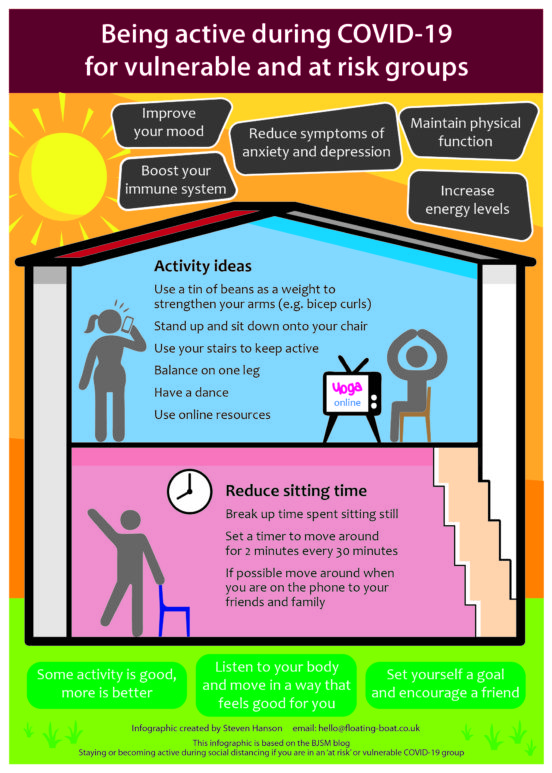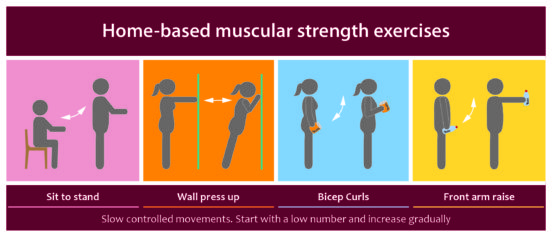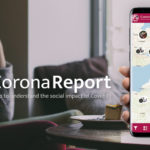During COVID-19, the World Health Organisation has defined vulnerable groups as those aged over 60 years (regardless of health condition), and those with underlying health conditions, such as cardiovascular disease, diabetes, chronic respiratory disease, and cancer. Additionally, the UK Government has identified pregnant women as an ‘at risk’ group. The benefits of physical activity for these groups are well known and emphasised in the 2019 UK physical activity guidelines.[1] As well as physical benefits, being active promotes emotional well-being.[2] With anxiety levels escalating, this matters more than ever. Normally, we tailor our physical activity advice around community provision, such as swimming, fitness classes and even walking with friends. These options may no longer be available and home-based activity could be your best option. Although some providers have tested home-based activity programmes for people with underlying health conditions, we need to adapt resources for those who need to stay indoors for long periods and practice social distancing. Many people might feel lonely and may not have a plan to maintain their health. More than ever, physical activity can help to reduce the effects of social isolation and prevent deconditioning caused by extended sitting. In this blog, we share some of the evidence about home-based physical activity, and provide practical advice to begin a home-based activity programme.
No equipment? No problem
If you are now having to spend more time at home than you are used to, increasing moving time and reducing sitting time are the key components to physical and emotional well-being.[3] Typically, we talk about four key components to maintaining physical wellbeing. These are endurance, strength, balance and flexibility. Here are some ideas to promote all of these:
Being active does not need to rely on fancy equipment. Recently, one man completed a marathon on his 7 metre balcony.[4] We would not suggest that you try this, but it shows that anything is possible even with very little space! We recommend making a daily commitment to do some form of activity, even walking around the room will give you some health benefits. If you have stairs, walk up and down them a few times. As we age, we tend to have less strength in our muscles. Studies recommend repeated movements of between 8- 10 repetitions to help reduce the effort of daily living activities such as stair climbing and carrying groceries. Doing muscular strengthening activities on at least two days per week has physical benefits. You can use kitchen items, such as tins of beans or filled water bottles, instead of hand weights. We suggest counting to three during each part of the activity (e.g. in a bicep curl, to three as you raise your arms and to three as you lower them again).
Practical activities to frequently break up sitting time can really improve your mood.[4] Try to stand up every 30 minutes if you are able, and move for two minutes. To improve general wellbeing, mood and energy levels, activities that increase breathing rate as well as muscle strength activities are important factors.[3] Dancing to music is fun, and if done regularly, is effective in improving quality of life and fitness for people with underlying conditions.[5] Other beneficial activities include walking inside and outside the home, Tai Chi and yoga.[6, 7] If you have to walk outside, remember to strictly observe the guidelines to stay at least two metres from anyone outside your household. A simple activity to improve your balance is walking heel-to-toe across the room. At first, you might find it helpful to hold on to the back of the sofa for stability. Although there is no definitive threshold to achieve benefits, for some people, small changes (e.g. increasing the number of times you stand from sitting throughout the day) can improve physical function within a few weeks.[8] Overall, the key message is it does not really matter what you do, as long as you do something!
How can I use technology to be more active?
If you have a mobile phone, computer or television with internet access, there are many online opportunities to help you be active. Mobile apps, text messaging and web-based solutions help people be physically active and improve wellbeing.[9] One study that brought together all the evidence for remote interventions for older adults found that booklets with goal setting, videos and telephone calls were effective in helping people to be more active.[10] Phone a friend and encourage each other to be active.
If you have a condition such as heart disease, the Heart Manual is a self-management book for people recovering from a heart attack, heart surgery, stroke and cancer. A digital format is now available and research shows that this is as effective as face-to-face cardiac rehabilitation for people with heart disease.[11] If you have a heart problem, telephone your cardiac rehabilitation team and ask what is available.
Physical activity is safe if you are pregnant.[12] Choices should reflect activity levels pre-pregnancy and include strength activities. If you were not active before, do not suddenly take up strenuous activity. You should be able to hold a conversation as you exercise when pregnant. If you become breathless as you talk, reduce your intensity.
Overall, the good news is that many activity providers are working very hard to make sure that there is access to online resources to help you. Check what your local leisure provider is offering. We recommend this online booklet for ideas on home-based activities http://www.laterlifetraining.co.uk/wp-content/uploads/2015/08/OEP-Home-Ex-Booklet-FullS_A4.pdf
We have constructed the above infographic using evidence-based principles on how to construct and deliver messages to promote physical activity among the ‘at risk’ or vulnerable group during this global pandemic.[14]
Who is this infographic for?
The infographic is for all adults aged 70+ years, pregnant women, or those with underlying conditions, who are staying at home. This population may be facing unprecedented restrictions to travel, social, and family life.
What is the aim of the infographic?
The aim of the infographic is to give people classed as ‘at risk’ or vulnerable ideas about how to remain safely active during COVID-19 and to motivate them to do so. We hope to achieve this through increasing awareness and knowledge of physical activity benefits, and by improving confidence to be active during this pandemic.
What is the content of the infographic?
Evidence supports the use of gain-framed messages (information on the benefits of physical activity) with particular focus on the short-term social and mental health benefits.[15] We have positively framed messages on links between physical activity and mood, stress, energy levels/fatigue, depressive symptoms, and anxiety. We have given practical examples about “how to” remain active during COVID19.
How should the infographic be used?
We encourage the sharing of the infographic to friends and family through online channels (Twitter, Facebook, WhatsApp etc.). You could print out the infographic to remind you to remain active.
***
Lis Neubeck 1,2 (corresponding author), Sheona McHale 1 Chloë Williamson 3, Paul Kelly 3Alice Pearsons 1, Steven Hanson 4, Coral L Hanson 1
1 School of Health and Social Care, Edinburgh Napier University, Sighthill Campus, Edinburgh, EH11 4DN, UK. Email: c.hanson@napier.ac.uk Tel: +44 7908861666
2 Sydney Nursing School, Charles Perkins Centre, University of Sydney, Australia
3 Physical Activity for Health Research Centre, Institute for Sport, Physical Education and Health Sciences, University of Edinburgh, Edinburgh, UK
4 Floating Boat Design Solutions, Stocksfield, UK
References
- UK chief medical officers, UK Chief Medical Officers’ Physical Activity Guidelines. [Date accessed 25/03/2020] https://assets.publishing.service.gov.uk/government/uploads/system/uploads/attachment_data/file/832868/uk-chief-medical-officers-physical-activity-guidelines.pdf. 2019
- World Health Organisation, Global action plan on physical activity 2018-2030: more active people for a healthier world.
- Gibson‐Moore, H., UK Chief Medical Officers’ physical activity guidelines 2019: What’s new and how can we get people more active? Nutr Bull, 2019. 44(4): p. 320-328. doi:10.1111/nbu.12409
- The Guardian, Man runs marathon on 7-metre balcony during French lockdown avaliable at https://www.theguardian.com/world/2020/mar/21/man-runs-marathon-on-7-metre-balcony-during-french-lockdown [Accessed 23/03/2020].
- Gomes Neto, M., M.A. Menezes, and V.O. Carvalho, Dance therapy in patients with chronic heart failure: a systematic review and a meta-analysis. Clin Rehabil, 2014. 28(12): p. 1172-1179. doi:10.1177/0269215514534089
- Chen, Y.-W., et al., The effect of Tai Chi on four chronic conditions—cancer, osteoarthritis, heart failure and chronic obstructive pulmonary disease: a systematic review and meta-analyses. Br J Sports Med, 2016. 50(7): p. 397-407. doi:10.1136/bjsports-2014-094388
- Thayabaranathan, T., et al., Determining the potential benefits of yoga in chronic stroke care: a systematic review and meta-analysis. Top Stroke Rehabil, 2017. 24(4): p. 279-287.
- Rosenberg, D.E., et al., The feasibility of reducing sitting time in overweight and obese older adults. Health Educ Behav, 2015. 42(5): p. 669-676. doi:10.1177/1090198115577378
- Jin, K., et al., Telehealth interventions for the secondary prevention of coronary heart disease: A systematic review and meta-analysis. Eur J Cardiovasc Nurs, 2019. 18(4): p. 260-271. doi:10.1177/1474515119826510
- Zubala, A., et al., Promotion of physical activity interventions for community dwelling older adults: A systematic review of reviews, PLoS One. 2017. doi: 1371/journal.pone.0180902
- Clark, M., T. Kelly, and C. Deighan, A Systematic Review of the Heart Manual Literature. Eur J Cardiovasc Nurs, 10(1): p. 3-13. doi:10.1016/j.ejcnurse.2010.03.003
- National Health Service. Exercise in pregnancy Your pregnancy and baby guide https://www.nhs.uk/conditions/pregnancy-and-baby/pregnancy-exercise/ [Accessed 26/03/2020] 2020.
- Latimer, A.E., L.R. Brawley, and R.L. Bassett, A systematic review of three approaches for constructing physical activity messages: what messages work and what improvements are needed? Int J Behav Nutr Phys Act, 2010. 7(1): p. 36. doi:10.1016/ 1186/1479-5868-7-36
- Williamson, C., et al., A conceptual framework for physical activity messaging. Int J Behav Nutr Phys Act, 2020 (in press)
- C., et al., A conceptual framework for physical activity messaging. ResearchGate, 2019 (pre-print)
Reproduced from Neubeck L, McHale S, Williamson C, Kelly P, Pearsons A, Hanson S, Hanson C.L. (2020). For the ‘at-risk’ or vulnerable COVID-19 group: staying or becoming active during social distancing.British Journal of Sports Medicine Blog Published Online First: (08/04/2020)https://blogs.bmj.com/bjsm/2020/04/08/for-the-at-risk-or-vulnerable-covid-19-group-staying-or-becoming-active-during-social-distancing/ with permission from BMJ Publishing Group Ltd.











Comments by abhatias